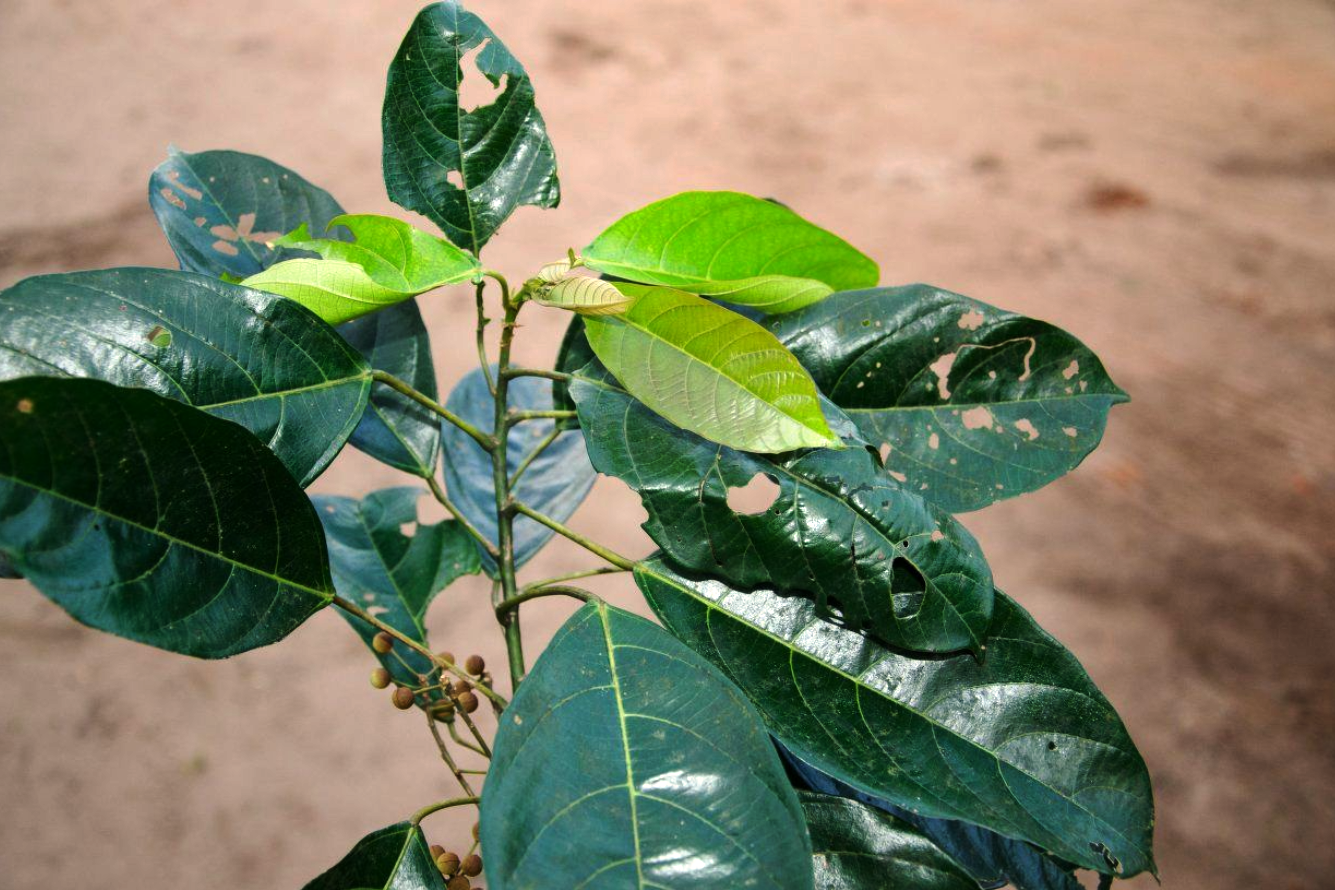Macaranga barteri

|
|
Macaranga barteri Common Names: Macaranga, Parasol Leaf Tree, Forest
Macaranga Scientific
Classification Kingdom: Plantae Phylum: Angiosperms Class: Eudicots Order: Malpighiales Family: Euphorbiaceae Genus: Macaranga Species: M. barteri Synonyms: Macaranga heudelotii var. nitida Beille, Macaranga rowlandii Prain Morphological Description Macaranga barteri is a deciduous shrub or small tree native to tropical
Africa, typically growing 5–12 m tall. Its key features include: · Habit: Shrub or small tree with a slender, often crooked trunk and
a spreading, open canopy. · Stem: Bark smooth, greyish-brown, exuding a reddish latex when cut;
branches glabrous. · Leaves: Alternate, large, 15–30 cm long, 10–20 cm wide, broadly
ovate to heart-shaped, with entire margins and a glossy upper surface; petioles
long, 10–25 cm (Burkill, 1994). · Flowers: Small, greenish-yellow, unisexual, in axillary panicles
(male) or racemes (female); male flowers with 2 stamens, female flowers with a
lobed calyx. · Fruit: Small, globose capsules, 5–8 mm in diameter, green turning
black when ripe, containing 2–3 seeds (Ogundajo et al., 2017). Its large, parasol-like
leaves and latex distinguish it within the Euphorbiaceae family (Keay, 1989). Distribution and Habitat Macaranga barteri is native to West and Central Africa, thriving in specific
ecological niches: · Countries: Nigeria, Ghana, Cameroon, Sierra Leone, Ivory Coast, Togo,
Democratic Republic of the Congo. It occurs in secondary
forests, forest edges, and disturbed areas at elevations of 50–800 m,
preferring moist, well-drained soils (pH 5.0–6.5) and partial shade. It is a
pioneer species, often colonizing cleared land (Burkill, 1994). Ethnopharmacology Macaranga barteri, a plant native to parts of Africa, has been
traditionally used to treat various ailments, including gastric ulcers, boils,
coughs, and wounds. Scientific studies have demonstrated that its aqueous leaf
extract possesses anti-ulcer properties, effectively treating gastric ulcers at
doses ranging from 125 to 500 mg/kg body weight. Additionally, the plant
exhibits promising antibacterial and antifungal activities, supporting its
traditional use in treating infections. Chemical profiling has identified
bioactive constituents in the leaves with significant antioxidant properties,
suggesting potential therapeutic applications in managing oxidative
stress-related conditions. Furthermore, extracts from the stem bark have been
found to exert anti-inflammatory and anti-hyperalgesic activities in murine
models, indicating potential for pain and inflammation management. The aqueous
leaf extract has also shown antidepressant-like effects in animal studies, with
mechanisms involving serotonergic and α₁-adrenergic receptors. These findings
highlight the therapeutic potential of Macaranga
barteri in various medicinal applications. · Antiviral: Leaf extracts in Nigeria treat viral infections. Ogbole et
al. (2018) found methanol extracts (IC₅₀ 0.028 ng/mL for E7, 0.0017 ng/mL for
E19) inhibited echoviruses E7 and E19, linked to flavonoids. · Anti-inflammatory/Analgesic: Stem bark in Ghana relieves pain and
swelling. Asante-Kwatia et al. (2019) showed hydro-alcoholic extract (300
mg/kg) reduced carrageenan-induced edema in rats by 64.11%, due to
ellagitannins like macabarterin. · Anticancer: Leaves in Nigeria are used for tumors. Siew et al. (2023)
demonstrated leaf extract (IC₅₀ 27.85 μg/mL) induced apoptosis in HT-29
colorectal cancer cells, attributed to prenylated flavonoids. · Antimicrobial: Root decoctions in Cameroon treat infections. Ogundajo et
al. (2017) confirmed leaf extracts (MIC 50 μg/mL) inhibited Staphylococcus aureus and Escherichia coli. · Antioxidant: Bark in Togo combats oxidative stress. Asante-Kwatia et al.
(2019) reported DPPH scavenging (IC₅₀ 89.37 mg/kg), linked to phenolic
compounds. · Wound Healing: Leaf poultices in Sierra Leone promote healing. Traditional
use aligns with antimicrobial and anti-inflammatory effects (Ogundajo et al.,
2017). Phytochemicals include
flavonoids (quercetin, kaempferol), alkaloids, tannins, ellagitannins
(macabarterin), and prenylated compounds, driving its therapeutic potential
(Ngoumfo et al., 2008; Siew et al., 2023). ⚠ Toxicity Profile: Leaf extracts showed high cytotoxicity (CC₅₀
0.27 μg/mL) in Vero cells, suggesting caution at high doses. No acute toxicity
observed in rats at 2,000 mg/kg orally, but latex may cause skin irritation
(Ogbole et al., 2018; Ogundajo et al., 2017). Additional Uses · Timber/Fuel: Wood used for light construction and firewood in rural areas
(Burkill, 1994). · Ecological: Pioneer species aiding reforestation in degraded lands
(Keay, 1989). · Cultural: Leaves used in Nigerian rituals for purification (Ogundajo
et al., 2017). References
External Links More Pictures |
|
| Compounds of Macaranga barteri | |
| References |